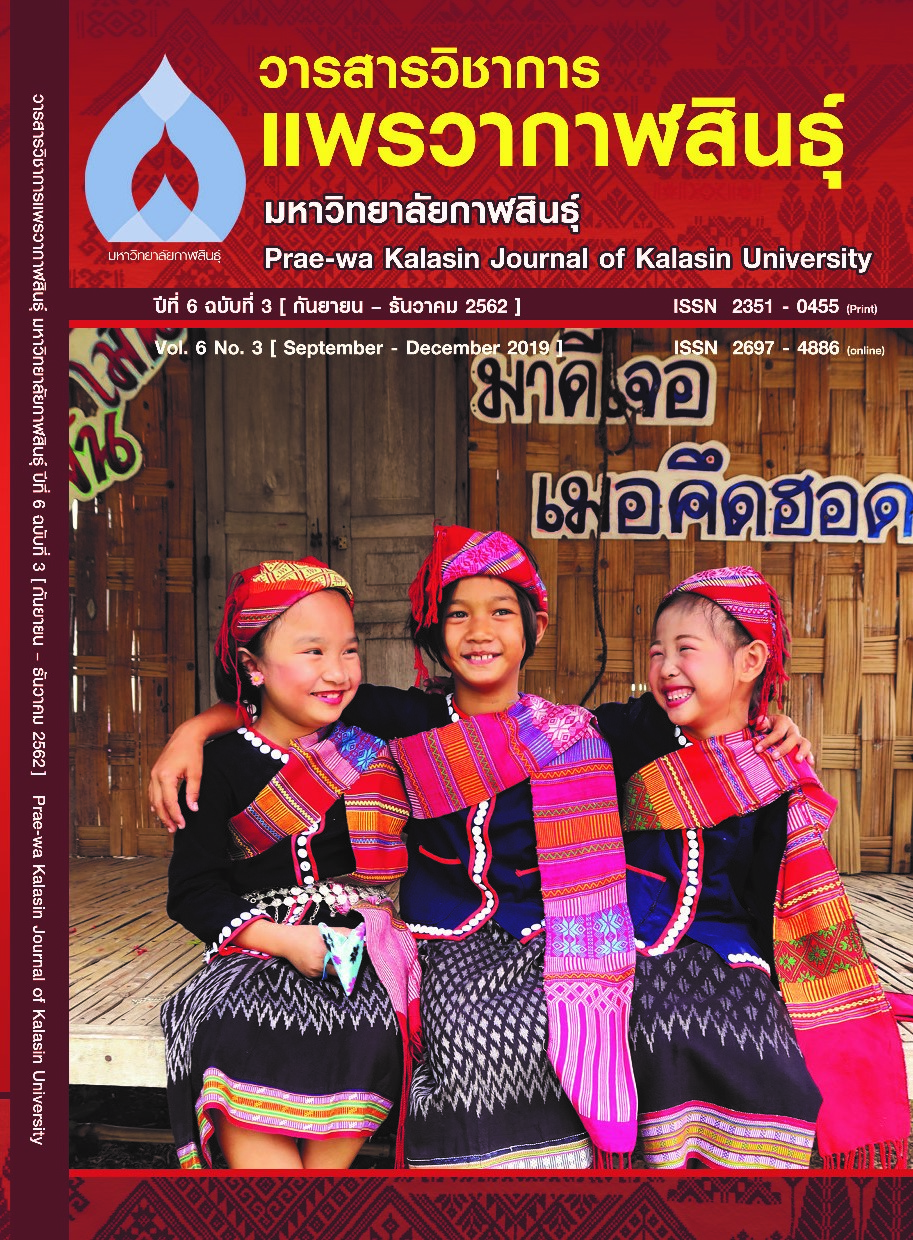Effects Of Cooperative Learning STAD Technique And SSCS Model Toward Mathematical Problem Solving Abilities On Pythagorean Theorem Of Mathayomsuksa II Students
Main Article Content
Abstract
The purpose of this research were 1) to compare mathayomsuksa 2 students’ mathematical problem solving abilities on Pythagorean theorem before and after the use of cooperative learning STAD technique and SSCS model 2) to compare mathayomsuksa 2 students’ mathematical problem solving abilities on Pythagorean theorem after the use of cooperative learning STAD technique and SSCS model with criterion of 70 percent. The target group consisted of 21 students in mathayomsuksa 2 during a second semester of the academic year 2018 from Khonkaenwit-tayaserm school, Tha Khantho District, Kalasin Province. The research instruments were 4 mathematic lesson plans using STAD technique with SSCS model and mathematics problem solving abilities test on Pythagorean theorem. The data were statistically analyzed by using percentage, mean, standard deviation and t – test for Dependent Samples and t – test One Samples Test. The results showed that 1) mathayomsuksa 2 students’ mathematical problem solving abilities on Pythagorean theorem after the use of cooperative learning STAD technique and SSCS model had higher than before learning at the .05 level of significance. The students’ pretest and posttest mean scores of mathematical problem solving abilities were 6.43 or 16.07 percent and 34.14 or 85.35 percent respectively. 2) mathayomsuksa 2 students’ mathematical problem solving abilities on Pythagorean theorem after the use of cooperative learning STAD technique and SSCS model had higher than the 70 percent criterion at .05 level of significance. The students’ posttest mean scores of mathematical problem solving abilities was 34.14 or 85.35 percent.
Article Details
References
จุฑามาศ หงษ์คำ, เกื้อจิตต์ ฉิมทิม, และ เจียมศักดิ์ ตรีศิริรัตน์. (2557). การพัฒนากิจกรรมการเรียนรู้คณิตศาสตร์โดยใช้รูปแบบร่วมมือกันเรียนรู้เทคนิค STAD ที่เน้นการแก้ปัญหาแบบ SSCS เรื่อง ทฤษฎีบทพีทาโกรัส ชั้นมัธยมศึกษาปีที่ 2. วารสารศึกษาศาสตร์ มหาวิทยาลัยขอนแก่น, 37(4), 17-24.
ชัยวัฒน์ สุทธิรัตน์. (2554). 80 นวัตกรรมการจัดการเรียนรู้ที่เน้นผู้เรียนเป็นสำาคัญ (พิมพ์ครั้งที่ 4). กรุงเทพฯ: แดเน็กซ์ อินเตอร์คอร์ปอเรชั่น.
พระราชบัญญัติการศึกษาแห่งชาติ. (2553). พระราชบัญญัติการศึกษาแห่งชาติ พ.ศ. 2542 แก้ไขเพิ่มเติม (ฉบับที่ 2) พ.ศ. 2545 และ (ฉบับที่ 3) พ.ศ. 2553 ราชกิจจานุเบกษา เล่มที่ 127 ตอนที่ 45ก หน้า 1-3.
ภิญญดา กลับแก้ว. (2560). การศึกษาผลสัมฤทธิ์ทางการเรียนวิชาคณิตศาสตร์และความสามารถในการแก้ปัญหาทางคณิตศาสตร์ ของนักเรียนชั้นมัธยมศึกษาปีที่ 2 เรื่องสมการกำลังสองตัวแปรเดียวโดยใช้รูปแบบ SSCS โรงเรียน มอ.วิทยานุสรณ์ จังหวัดสงขลา. วารสารศึกษาศาสตร์ปริทัศน์, 29(2), 149-156.
มุกดา ใสวารี, และ หล้า ภวภูตานนท์. (2560). การพัฒนากิจกรรมการเรียนรู้คณิตศาสตร์ โดยใช้รูปแบบร่วมมือกันเรียนรู้ด้วยเทคนิค STAD ที่เน้นการแก้ปัญหา แบบ SSCS เรื่อง ลำดับอนันต์และอนุกรมอนันต์ชั้นมัธยมศึกษาปีที่ 6. KKU Research Journal (Graduate Studies) Humanities and Social Sciences, 4(3), 28-38.
โรงเรียนขอนแก่นวิทยาเสริม . (2561). ข้อมูลทั่วไปโรงเรียนขอนแก่นวิทยาเสริม. เรียกใช้เมื่อ 29 มิถุนายน 2561 จาก http://data.bopp-obec.info/web/index_view.php?School_ID=1046030281&page=info
ลัดดา ภู่เกียรติ. (2547). โครงงานเพื่อการเรียนรู้หลักและแนวทางการจัดกิจกรรม. กรุงเทพฯ: จุฬาลงกรณ์มหาวิทยาลัย.
วิภาดา คล้ายนิ่ม, ชานนท์ จันทรา, และ ต้องตา สมใจเพ็ง. (2560). การศึกษาผลสัมฤทธิ์ทางการเรียนคณิตศาสตร์ของนักเรียนช้ันมัธยมศึกษาปีที่ 5 เรื่องความน่าจะเป็น โดยใช้รูปแบบ SSCS. วารสารศึกษาศาสตร์ มสธ., 10(2), 329-345.
สถาบันทดสอบทางการศึกษาแห่งชาติ. (2560). เข้าถึงได้จาก http://www.newonetresult.niets.or.th/AnnouncementWeb/Login.aspx
สถาบันส่งเสริมการสอนวิทยาศาสตร์และเทคโนโลยี. (2551). หนังสือเรียนสาระการเรียนรู้พื้นฐานคณิตศาสตร์ กลุ่มสาระการเรียนรู้คณิตศาสตร์ ชั้นมัธยมศึกษาปีที่ 2. กรุงเทพฯ: โรงพิมพ์ สกสค. ลาดพร้าว.
สำนักงานคณะกรรมการการศึกษาแห่งชาติ. (2545). พระราชบัญญัติการศึกษาแห่งชาติ พ.ศ. 2542 และแก้ไขเพิ่มเติม (ฉบับที่ 2) พ.ศ. 2545. กรุงเทพฯ: พริกหวานกราฟฟิก.
สิริพร ทิพย์คง. (2545). หลักสูตรและการสอนคณิตศาสตร์. กรุงเทพฯ: พัฒนาคุณภาพวิชาการ (พว).
สุภัทรา สิริรุ่งเรือง. (2554). ผลการจัดกิจกรรมการเรียนรู้โดยใช้รูปแบบ SSCS ที่มีต่อความสามารถในการเรียนคณิตศาสตร์ เรื่อง "การประยุกต์ของสมการเชิงเส้นตัวแปรเดียว" ของนักเรียนชั้นมัธยมศึกษาปีที่ 2โรงเรียนเบญจมเทพอุทิศ จังหวัดเพชรบุรี. วารสารศึกษาศาสตร์ปริทัศน์, 26(1), 13-22.
อำนวย แน่นอุดร, และ นิลมณี พิทักษ์. (2553). การศึกษาทักษะกระบวนการกลุ่มและผลสัมฤทธิ์ทางการเรียน กลุ่มสาระการเรียนรู้สังคมศึกษาศาสนาและวัฒนธรรมของนักเรียนชั้นประถมศึกษาปีที่ 6 โดยใช้รูปแบบการสอนแบบร่วมมือกันเรียนรู้แบบ STAD โรงเรียนบ้านกุดจิก อำเภอกุมภวาปี จังหวัดอุดรธานี. วารสารศึกษาศาสตร์ มหาวิทยาลัยขอนแก่น, 4(2), 175-183.
Kurniawati, L., และ Siti, B. F. (2014). Problem Solving Lear Ning Approach Using Search, Solve, Create And Share (SSCS) Model And The Student's Mathematical Logical Thinking Skills. Proceeding of International Conference On Research, Implementation And Education Of Mathematics And Sciences., 315-322. Retrieved from https://core.ac.uk/reader/33509377
Edmonds, W. A., & Kennedy, T. D.. (2013). An Applied Reference Guide to Research Designs: Quantitative, Qualitative, and Mixed Methods: Quantitative, Qualitative, and Mixed Methods. Sage.
